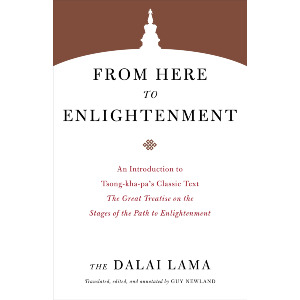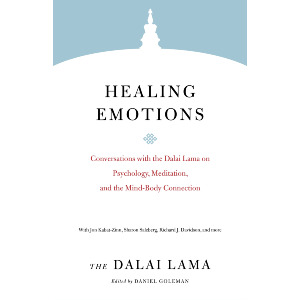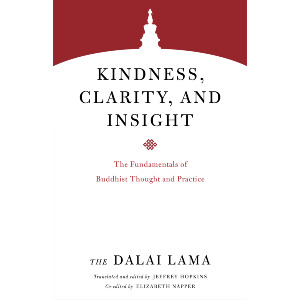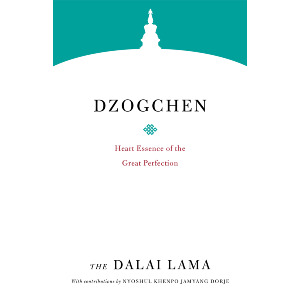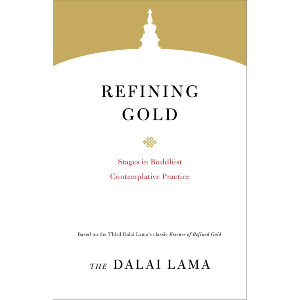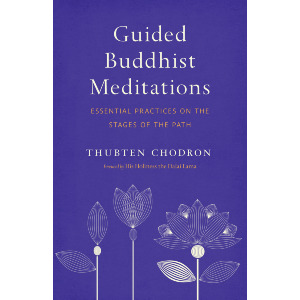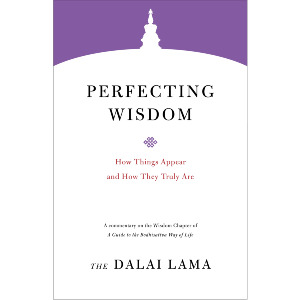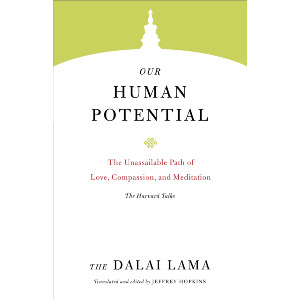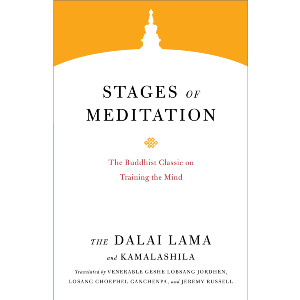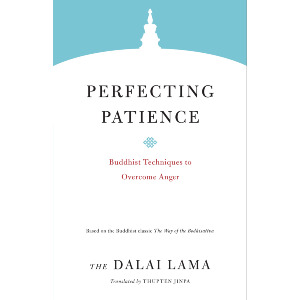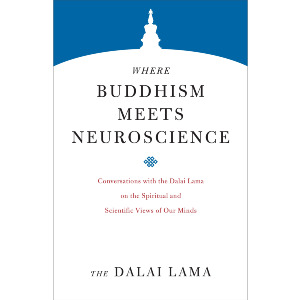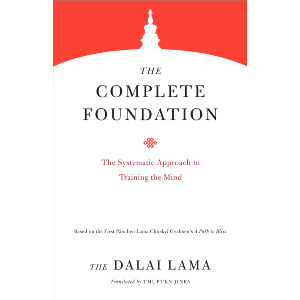| The following article is from the Summer, 1998 issue of the Snow Lion Newsletter and is for historical reference only. You can see this in context of the original newsletter here. |
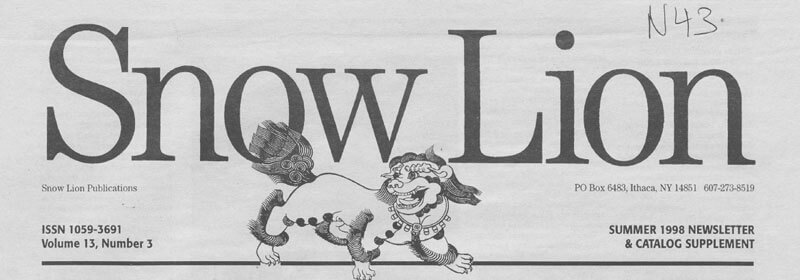
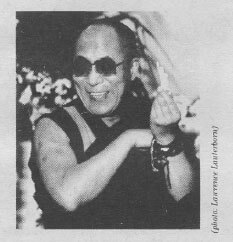 H.H. the Dalai Lama in New York teaches In the Spirit of Manjushri
H.H. the Dalai Lama in New York teaches In the Spirit of Manjushri
by Victoria Huckenpahler
In a historic event co-sponsored by Tibet House and the Dharma Drum Mountain Buddhist Association, H.H. the Dalai Lama offered a three-day teaching (May 1-3) before a predominantly Chinese audience on the Tradition of Transcendent Wisdom, concluding with a dialogue between himself and Ven. Master Sheng-yen, a renowned scholar, author, and teacher of Chinese Zen Buddhism.
From the moment that the Master led His Holiness out by the hand onto the stage of the Roseland Ballroom, while the ordained Chinese sangha formally chanted an invitation accompanied by delicate ringing bells and wafting incense, divine courtesy prevailed. Throughout the teachings, Master Sheng-yen, tall, spare, and with robes elegantly draped around him, gazed on the Dalai Lama with affectionate respect, took notes, and in his concluding remarks called His Holiness my Dharma brother. The previous evening, His Holiness had set the tone for the teachings when, at the Light of Truth Award, he remarked on the importance of the Dharma for the Chinese people, stressing that it is for this reason in part that it is unwise to isolate them. At Roseland he graciously said that since Buddhism had spread from In dia to China before traveling to Tibet, he considered the Chinese as senior Dharma brothers and sisters.
In succeeding days, His Holiness gave extensive commentary on the Tibetan Wisdom tradition, drawing on the Fifth Dalai Lama's Lam Rim text, and on Tsong Khapa's Three Principal Elements of the Path which describes the practices of renunciation, bodhicitta, and insight into emptiness. Elaborating on each category, H.H. stated that renunciation can only be developed once one has a conviction that mental afflictions can be removed. Further, to realize that liberation is possible we must recognize that the sense of self, which appears so separate from body and mind as to be, in His Holiness's words our boss, is in fact illusory because even at the level of subtlest particles we are in a continuous state of flux. We can't just ask ignorance to leave or pray that it goes away, he said. Rather, we must cultivate an insight into the selflessness of persons and phenomena. If there were no possibility of ending suffering, we might as well indulge in drugs, wine, and excessive sleep!
Commenting on the bodhicitta section of the Fifth Dalai Lama's Lam Rim, His Holiness stressed that while one could attain bodhicitta out of faith and devotion, it would not be as firm as when grounded in an understanding of emptiness. Here he likened the highest form of bodhicitta to what he termed cowherder's mentality, in which like a herder who follows behind a flock, only after leading others to enlightenment does one wish it for oneself. Don't confuse compassion with pity, he warned. There should be no sense of superiority. Authentic compassion means viewing its object as supreme. There should be a sense of connectedness which cannot exist in the normal state in which we discriminate and fluctuate. Be universal and unbiased. In words which are particularly poignant given his own trials, His Holiness went on to describe the correct posture to adopt toward enemies: See enemies as critical to your well-being because without somebody provoking us we have no opportunity to practice. For example, people who have had an easy childhood have little resilience. They are soft and unchallenged, whereas someone who has met with challenge since childhood develops a much stronger personality. There is a big difference between the way the two types meet difficulties. I respect the Kadampa masters who value hardships. Tsong Khapa said in a prayer: May I feel especially close and dear to those who continue to inflict harm on me.'
Throughout his exposition of Tsong Khapa's text, His Holiness stressed the understanding of emptiness as fundamental to all progress. When I think of my own way of being, he said, the little strength I have comes not from being Dalai Lama or a fully ordained monk, but from an altruistic motivation and an awareness of the validity of emptiness. As a youth, he said, when I began to sense liberation was a real possibility, I had a strong desire to seek it because I thought if I attained it I could then take a long break! So my wish was selfish. Commenting on the importance of time as a component of the path, he said, Please don't think I am claiming I'm a Bodhisattva or that I've already realized emptiness. Part of the story is that it takes time. Developing understanding is one thing, experience is something else. Don't be spoiled by the rhetoric in Tantra about attaining liberation in one lifetime. When I was young, I told my tutor that since the Sutra path is so long, maybe I'd take Tantra. He pointed out that this was the wrong motivation. True Tantric practitioners have already been working for aeons.
One of the remarkable features of the event was the moral strength that His Holiness projected from the stage. Abandoning all hint of anger or self-pity, he seems to have clearly transmuted the formidable obstacles he has faced into occasions for practice, a fact that was echoed in his tribute to Tsong Khapa for having valued criticism because it showed him where his weaknesses lay. Said His Holiness: This is called transforming adversity into favorable conditions.
On the final morning, His Holiness conferred the White Manjushri initiation, commenting, I cannot guarantee you will receive total wisdom from this, but I can guarantee you won't become any dumber! He also stressed the importance of self-reliance stating that while dependence on the blessings of external beings is part of the Buddhist tradition, sometimes Tibetans take this to the extreme.
The program concluded with a dialogue between himself and Master Sheng-yen which stressed the common ground rather than the differences between the Chinese and Tibetan traditions, and which was laced with mutual generosity and good humor.
With his ever-lively intellect, His Holiness interrupted the Chinese master with so many questions that the latter jokingly said, You have caused me to run overtime with all your questions. Now that should be deducted from your time!
His Holiness's mentioned a recent incident in Japan where he attended a conference on diverse Buddhist traditions. There he was approached by a Theravadan monk who slightly reproached him for engaging in more dialogues with Christian spiritual leaders than with representatives of other Buddhist sects. His Holiness conceded that there is indeed need for change in this regard, otherwise sectarianism could increase.
As usual, throughout the program His Holiness encouraged questions from the audience, in particular from the Chinese community. When a participant asked why compassion and pain always go hand-in-hand, His Holiness replied, Compassion arises as a natural response out of empathy for beings. But the person having compassion experiences a different pain from the kind one suffers against one's wish. There is a degree of voluntariness. Pain here is taken on for a higher purpose. When asked how the karmic continuum is carried over to the next lifetime, His Holiness advised that we study how memory functions within this life. There is a time lapse between an experience and our recollection of it, and a connection obviously exists between the two, but His Holiness admitted that it was philosophically difficult to say on what faculty karmic imprints are stored. According to the Mind-Only School, the basis is the alaya vijnana (all-base mind), but not all schools agree. When asked if the faults we see in another person actually exist or if they are merely our projection, His Holiness replied, In lojong (mind training) we operate from the premise that there is a distinction between enemies and friends, so while we often project characteristics that don't exist in a person, our perceptions are not always projections alone. But what is important is how we respond. If someone is really wrong, we shouldn't respond in a hateful manner, but at the same time patience should not be confused with the idea that we should put up with injustice.

If someone is really wrong, we shouldn't respond in a hateful manner, but at the same time patience should not be confused with the idea that we should put up with injustice.

His Holiness's Wisdom Teachings were so dense in their implications that any attempt to recount them is like culling mere drops from a vast ocean.
Throughout the teachings, His Holiness showed his unusual talents for combining traditional ritual, the highest levels of scholarship, and readily accessible heart advice. That he does so with humor, yet a pervasive sense of the sacred accounts for his ability to pierce the collective heart of his audience. One is left with the indelible images of His Holiness and Master Sheng-yen leaving the stage each day hand-in-hand, and of His Holiness repeatedly joining his palms in supplication as his translator spoke the names of earlier lineage masters. Above all, his willingness to reconnect the Chinese people with their ancient spiritual traditions is, under the circumstances, the unmistakable hallmark of a holy being.


